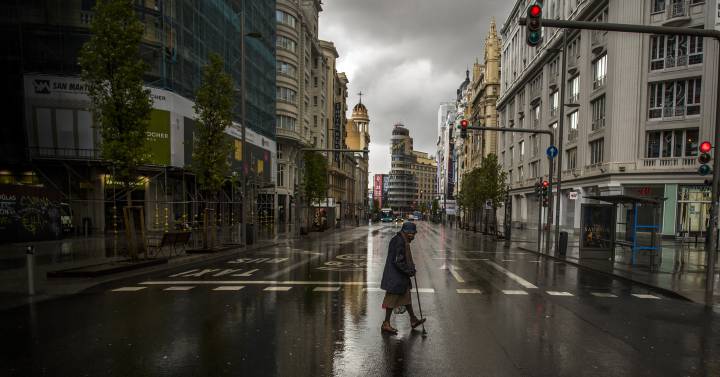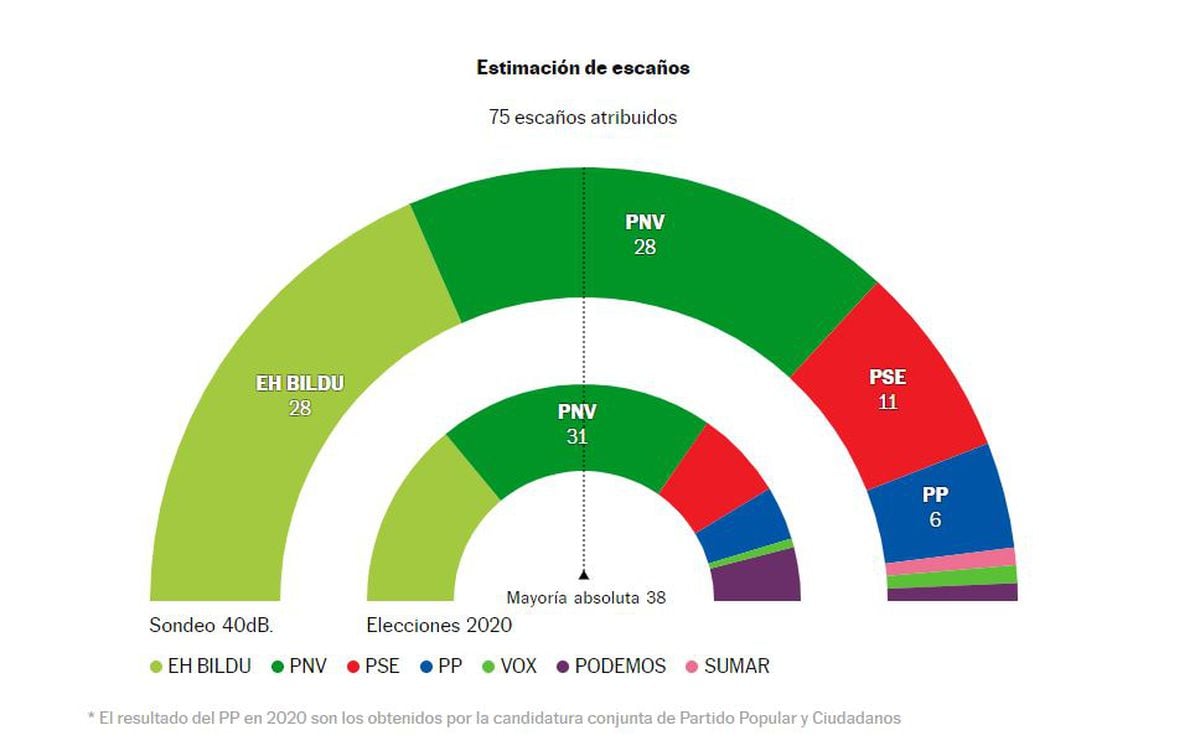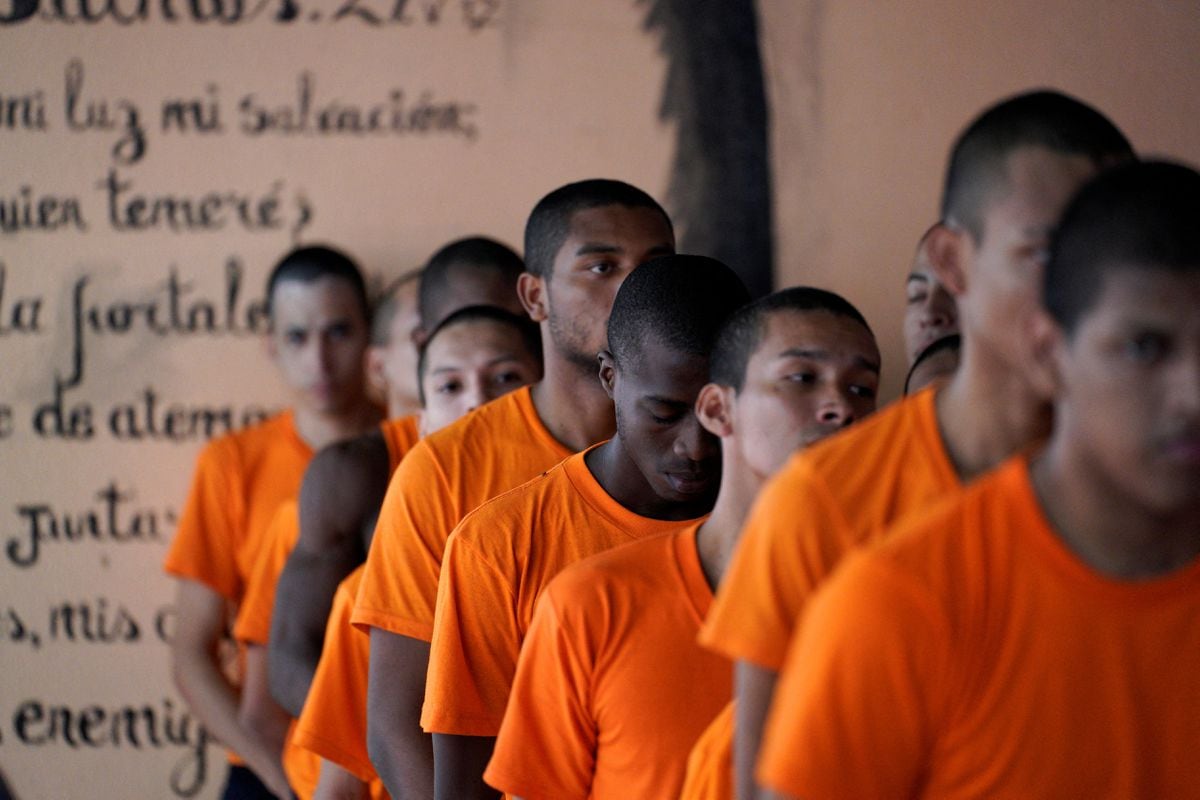1Several deputies of Unidos Podemos wipe their tears at the end of the session, among them Pablo Iglesias and Irene Montero (in the foreground), during the debate on the investiture of Pedro Sánchez, candidate for the presidency of the Government on January 7.
Uly Martin
2In March, the newspaper EL PAÍS began a key stage with the implementation of a digital subscription model.
From this moment on, readers began to pay to access some content, such as opinion articles from its columnists.
In the image, some of these columnists: from left to right, Marta Sanz, Manuel Vicent, Elvira Lindo, Antonio Muñoz Molina, Almudena Grandes, Xavier Vidal-Folch, David Trueba, Nuria Labari, Mario Vargas Llosa, Irene Vallejo, Juan José Millas, Julio Llamazares, Luz Sánchez Mellado, Rosa Montero and Manuel Jabois, at the EL PAÍS facilities.
Samuel Sánchez \ Carlos Rosillo
3The spread of the virus in Spain and the declaration of a state of alarm on March 14 left an unprecedented panorama: cities with almost no people or activity.
In the image, a woman crosses a pedestrian crossing on Madrid's Gran Vía, on March 23.
Samuel Sanchez
4First night of the arrival of the deceased by coronavirus at the Ice Palace of Madrid, enabled as a morgue for the conservation of the bodies on March 23, 2020. Faced with the large increase in deaths, the Community of Madrid began to use this enclosure as a deposit to house the bodies, since it allowed to keep a large number of them at low temperature.
Kike Para
5Two health workers embrace at the Severo Ochoa hospital in Leganés (Madrid), on March 26.
In those days, the pressure on hospitals had grown a lot.
This day there were 4,000 deaths in Spain, 56,000 infected, and 3,700 people admitted to intensive care.
That same afternoon, Minister Salvador Illa warned that the worst had yet to come: "We know that hospitalized cases and those admitted to intensive care units will reach their maximum peak a few days after the epidemic curve falls. According to different estimates , this occupation could reach its maximum level in the first days of April. ”Luis Sevillano
6The windows and balconies of Spain were filled with applause during the confinement to stop the covid.
Every afternoon, at eight o'clock, the Spaniards appeared to applaud the health workers who were on the front line fighting the pandemic.
In the image, a girl applauds through her loft window during the applause minute in honor of the toilets in Madrid in April.
David Exposito
7For a month and a half most Spanish children did not go out on the streets.
They could not use the excuse of going to work or shopping.
Experts warned that so long locked up could cause anxiety, obesity, and even educational problems.
In the image, two children look out the window of their house in Madrid, on April 14.
Andrea Comas.
On April 15, a nurse cares for a coronavirus patient in an adapted ICU in what was previously the cardiology critical area of the Gregorio Marañón in Madrid.
The largest hospital in the capital was completely transformed in 40 days to deal with covid-19.
"In 40 years I have not seen anything as dramatic as this, neither the 11-M nor the avian flu nor the rapeseed", commented José Eugenio Guerrero, head of the UCI.
Carlos Rosillo
9According to the National Strategy for the Homeless, in Spain there are some 33,000 homeless people, but Caritas ensures that it serves almost 40,000.
This last figure represents a 25% increase since the pandemic began.
Despite the fact that the most attended profile is that of a single man, Spanish and over 45, the reality is now much more diverse.
In the photograph, a homeless person eats on the steps of the Capitol cinema, on Madrid's Gran Via, in May.
Bernardo perez
10The Government of Spain and the Community of Madrid, with the help of the Army, set up a large hospital in the Ifema pavilions to relieve the hospital pressure that the capital was suffering.
From March 14, when the first patient entered until its closure on May 1, more than 4,000 infected people passed through this emergency health center.
Santi Burgos
11Members of the UME upon their arrival at the Granada train station to carry out cleaning and disinfection work, where they also carried out control and information actions for citizens to prevent the spread of the coronavirus.
The work of the UME during the first wave was very important, both in the disinfection of spaces, as well as in the assembly of field hospitals, transfer of the deceased, and developing security tasks.
Fermín Rodríguez
During the worst weeks of the first wave, the Collserola mortuary in Barcelona stored coffins of coronavirus victims in its underground parking lot.
At that time there were more than 200 coffins.
The funeral home has the capacity to store about 2,000.
Massimiliano Minocri
13On June 17, the Madrid Canal Theaters reopened their rooms to the public.
One of the measures to maintain physical distance was to place mannequins in the seats to separate the spectators.
The work represented was Israel Galván's adaptation of 'El amor brujo'.
Julian Rojas
14After six months without school, Spanish schoolchildren had to face the strangest return to school of their lives.
In the image, primary school students on the first day of class at the Paderborn public school in Pamplona, Navarra.
Javier Hernandez
15José García, an inhabitant of the Nuevo San Juan neighborhood in the community of La Lima (Cortés, Honduras), removes from the rubble trying to recover some of what was his furniture on November 24, 2020. García, like hundreds of Hondurans, lost everything after the passage of Storm Iota.
The off-season meteorological phenomenon left at least 40 dead, hundreds of flooded towns and damages to the road infrastructure of Honduras.
Gladys serrano
16 The coronavirus causes an eminently respiratory disease.
The process in the lungs was described right away: first, an infection, in which the pathogen damages what it finds in its path (throat, bronchi).
In the lungs, it destroys the alveoli, which are the mini-bags where the blood releases carbon dioxide and takes in oxygen.
In the image, a hospital without truce against covid-19.
A patient hospitalized in the high intensity care unit of the Josep Trueta hospital in Girona requires ventilatory support.
Toni Ferragut
17The grandchildren of Carolina Sacramento Ramos, 65, a sweet seller, originally from the State of Puebla, who died of covid-19 on September 15, 2020. Later, her family went to the civil pantheon of Chalco to place a cross.
Monica Gonzalez
18Erika Mejía, the 37-year-old Honduran domestic worker whom the Spanish health system tried to save at all costs during the highest peaks of the pandemic, was cremated on May 18 at the Guadalajara crematorium.
The woman died the day before in the intensive care unit of the Puerta de Hierro hospital.
She had been hospitalized for a month and a half, since she suffered respiratory failure after catching COVID-19, on May 18.
Jaime Villanueva
19A worker in the covid area at the Mónica Pretelini Sáenz Maternal Perinatal Hospital, of the Health Institute of the State of Mexico (ISEM), where eight women are treated with the SARS-CoV-2 virus, which causes the covid-19 disease , originating in the Valley of Mexico.
Monica Gonzalez
20Maximina works as a Primary Care nurse assisting those who need it at home, with limited means.
He did not stop doing his job for a single day during the confinement and afterwards, as far as he could, as the image shows.
She, a vocational nurse, comments that the continuous contact with the sick makes them somehow part of her life.
Being on the front line encourages bonding, as in the case of María and her two sons, Gerardo (wearing a tracksuit) and Pablo, who took care of their mother to the best of their ability.
In the image, Maximina checks Maria's state of health and carries out weekly cures, while her children ask her how they should follow up.
Monica Torres
21Dr. Manuel Lizárraga visits the home of a woman diagnosed with coronavirus and gives her a consultation, on July 19, 2020, in the Municipality of Macuspana, Tabasco (Mexico).
Nayeli Cruz
22The Military Emergency Unit (UME) in collaboration with Patrimonio disinfect the National Library and the National Archaeological Museum in Madrid on April 25.
Victor Sainz
23María Angeles Calzon, 94, with her daughter Marián Muñoz, 60, at the Concesol nursing home in Madrid.
In this residence, after the second wave, they allowed family visits, respecting all security measures.
Bald Elm
24Forest fire in Cualedro (Ourense), on September 14.
Galicia suffered at this time a wave of fires, which mainly affected the province of Ourense where more than 10 fires were declared in a few hours.
Oscar Corral
25A boy carries water in a bucket to bathe in one of the shanty camps built by sub-Saharan migrants in the Huelva town of Lepe.
Most of the people who live there work as temps.
A UN rapporteur published a report in February criticizing the harsh conditions in these settlements.
After visiting these shacks, Philip Alston declared: "they live like animals."
Paco Puentes
26On September 12, Moria, the largest refugee camp in Europe located on the island of Lesbos, burned in a fire that forced its 13,000 inhabitants to sleep in the open, already living in appalling human and sanitary conditions.
This incident once again focused on the ineffective response of the European Union to the migratory challenge and on the null capacity of its members to agree, who even today do not achieve a solution to the serious problem of refugees on this Greek island.
Alvaro Garcia
27Juan and Elisa Delibes pose at the door of the Casona de Sedano with a portrait of Miguel Delibes in the same position and in the same place;
on the tenth anniversary of his passing.
Ricardo Gutierrez
28The players of the national team celebrate Rodrigo's goal during the match between Spain and Germany at the Cartuja stadium in Seville on November 17.
La Roja embarrassed the German team with a historic 6-0, which also allowed them to reach the final phase of the League of Nations.
Alejandro Ruesga
29Several bathers jump into the sea at Bogatell beach, in Barcelona, during the partial reopening of the beaches after confinement by the coronavirus pandemic, on May 8.
Gianluca Battista
30During the first weeks of the pandemic and the state of alarm, access to masks was still limited.
Armenia, neighbor of sector six of the Cañada Real, wears a handmade one.
The largest irregular settlement in Europe has been without power since the beginning of October due to overloads caused by marijuana plantations.
Luis de Vega
EL PAÍS photographers offer a sample of their best images of 2020
2020-12-31T00:52:33.876Z

The covid-19 pandemic sets the gaze of our photojournalists when the year is about to end 1Several deputies of Unidos Podemos wipe their tears at the end of the session, among them Pablo Iglesias and Irene Montero (in the foreground), during the debate on the investiture of Pedro Sánchez, candidate for the presidency of the Government on January 7. Uly Martin 2In March, the newspaper EL PAÍS began a key stage with the implementation of a digital subscription model. From this moment on

/cloudfront-eu-central-1.images.arcpublishing.com/prisa/HXTIXWY4CZBOVEEG4LB5KEE354.jpg)
/cloudfront-eu-central-1.images.arcpublishing.com/prisa/6QHAX3YG3BEW7HBRAJ5JYQIUTM.jpg)

/cloudfront-eu-central-1.images.arcpublishing.com/prisa/YF7GIHYSMRN4JGNOYSGVWLH3ZY.jpg)


/cloudfront-eu-central-1.images.arcpublishing.com/prisa/TQLCMIDFSEQIOND2G54CLLK6VQ.jpg)
/cloudfront-eu-central-1.images.arcpublishing.com/prisa/5U35PX4BABDO5IHUZOPPKARVSU.jpg)

/cloudfront-eu-central-1.images.arcpublishing.com/prisa/KMEYMJKESBAZBE4MRBAM4TGHIQ.jpg)



